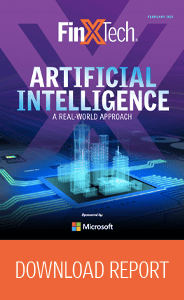Kiah Lau Haslett is the Banking & Fintech Editor for Bank Director. Kiah is responsible for editing web content and works with other members of the editorial team to produce articles featured online and published in the magazine. Her areas of focus include bank accounting policy, operations, strategy, and trends in mergers and acquisitions.

Artificial Intelligence: A Real-World Approach
Bank Director’s research report digs deep into how financial institutions could approach artificial intelligence, including potential projects, data hurdles and where the regulators stand.
Artificial intelligence — particularly generative AI — has captured everyone’s imagination.
The technology, which is trained on large data sets and can produce text, images, sounds and video, gained popularity through global engagement with ChatGPT, a chatbot developed by OpenAI that reached 100 million active users two months after it launched in late 2022. As ChatGPT crossed that threshold, Microsoft Corp. signaled its own commitment to AI’s potential with a multibillion-dollar, multiyear investment in OpenAI. And more developments could be coming: Investors poured $21.4 billion into generative AI through the first nine months of 2023, according to Pitchbook data.
The explosive use of the technology promises monumental change, including for banks. And it’s something that smaller institutions can leverage as they reshape their own organizations.
“Generative AI has really changed the game around AI in terms of accessibility,” says Daragh Morrissey, director of AI at Microsoft Worldwide Financial Services. “You don’t need to be a [big] Wall Street bank anymore to get this capability into the hands of your company.”
Artificial intelligence applications go far beyond generative AI’s capabilities. AI practitioners like to refer to a technique called “next best action,” a predictive approach that uses available data to recommend the next thing a company or person could do. And many financial institutions are already taking the next leap forward.
Use cases span across financial services, from using simple chatbots to interact with customers to flagging fraud to making it easier for employees to connect with the information they need. In “Artificial Intelligence: A Real-World Approach,” sponsored by Microsoft, bank leaders can expect to further their knowledge about how to approach this exciting technology, including:
- The impact of generative AI
- Identifying how your organization could use AI
- Working with partners
- Data management and privacy
- Navigating ethical and regulatory considerations
- A range of real-world projects, from analyzing transactions to customer service
- And a next-steps checklist that covers strategy, use cases and due diligence
Big, global banks have experimented with AI for years. Now, it’s time for community institutions to consider how artificial intelligence can revolutionize their own organizations. Click here to read the report and determine your institution’s next best action.




